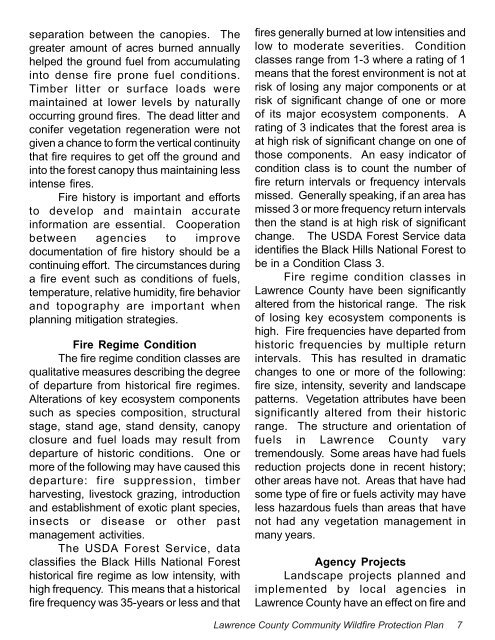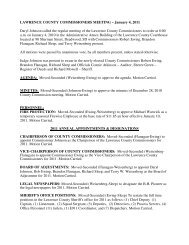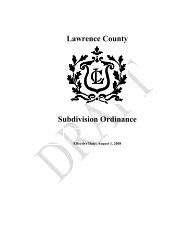Lawrence County Community Wildfire Protection Plan - Black Hills ...
Lawrence County Community Wildfire Protection Plan - Black Hills ...
Lawrence County Community Wildfire Protection Plan - Black Hills ...
You also want an ePaper? Increase the reach of your titles
YUMPU automatically turns print PDFs into web optimized ePapers that Google loves.
separation between the canopies. Thegreater amount of acres burned annuallyhelped the ground fuel from accumulatinginto dense fire prone fuel conditions.Timber litter or surface loads weremaintained at lower levels by naturallyoccurring ground fires. The dead litter andconifer vegetation regeneration were notgiven a chance to form the vertical continuitythat fire requires to get off the ground andinto the forest canopy thus maintaining lessintense fires.Fire history is important and effortsto develop and maintain accurateinformation are essential. Cooperationbetween agencies to improvedocumentation of fire history should be acontinuing effort. The circumstances duringa fire event such as conditions of fuels,temperature, relative humidity, fire behaviorand topography are important whenplanning mitigation strategies.Fire Regime ConditionThe fire regime condition classes arequalitative measures describing the degreeof departure from historical fire regimes.Alterations of key ecosystem componentssuch as species composition, structuralstage, stand age, stand density, canopyclosure and fuel loads may result fromdeparture of historic conditions. One ormore of the following may have caused thisdeparture: fire suppression, timberharvesting, livestock grazing, introductionand establishment of exotic plant species,insects or disease or other pastmanagement activities.The USDA Forest Service, dataclassifies the <strong>Black</strong> <strong>Hills</strong> National Foresthistorical fire regime as low intensity, withhigh frequency. This means that a historicalfire frequency was 35-years or less and thatfires generally burned at low intensities andlow to moderate severities. Conditionclasses range from 1-3 where a rating of 1means that the forest environment is not atrisk of losing any major components or atrisk of significant change of one or moreof its major ecosystem components. Arating of 3 indicates that the forest area isat high risk of significant change on one ofthose components. An easy indicator ofcondition class is to count the number offire return intervals or frequency intervalsmissed. Generally speaking, if an area hasmissed 3 or more frequency return intervalsthen the stand is at high risk of significantchange. The USDA Forest Service dataidentifies the <strong>Black</strong> <strong>Hills</strong> National Forest tobe in a Condition Class 3.Fire regime condition classes in<strong>Lawrence</strong> <strong>County</strong> have been significantlyaltered from the historical range. The riskof losing key ecosystem components ishigh. Fire frequencies have departed fromhistoric frequencies by multiple returnintervals. This has resulted in dramaticchanges to one or more of the following:fire size, intensity, severity and landscapepatterns. Vegetation attributes have beensignificantly altered from their historicrange. The structure and orientation offuels in <strong>Lawrence</strong> <strong>County</strong> varytremendously. Some areas have had fuelsreduction projects done in recent history;other areas have not. Areas that have hadsome type of fire or fuels activity may haveless hazardous fuels than areas that havenot had any vegetation management inmany years.Agency ProjectsLandscape projects planned andimplemented by local agencies in<strong>Lawrence</strong> <strong>County</strong> have an effect on fire and<strong>Lawrence</strong> <strong>County</strong> <strong>Community</strong> <strong>Wildfire</strong> <strong>Protection</strong> <strong>Plan</strong> 7





